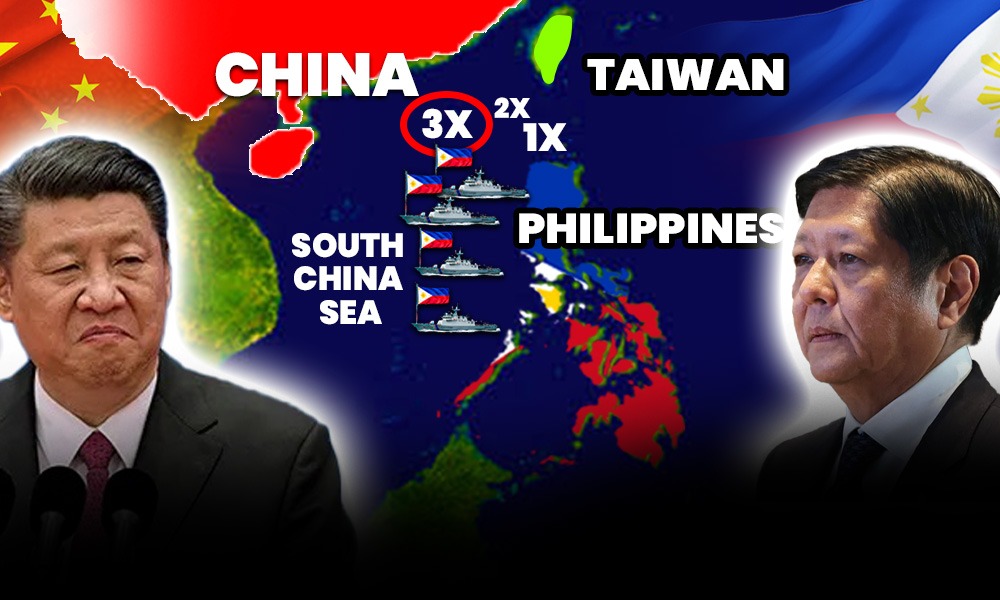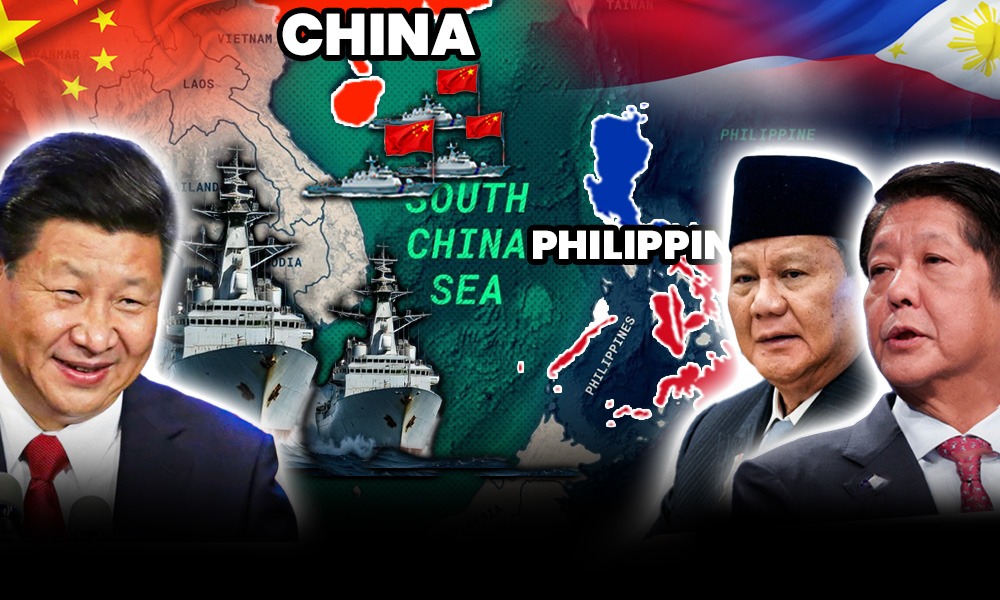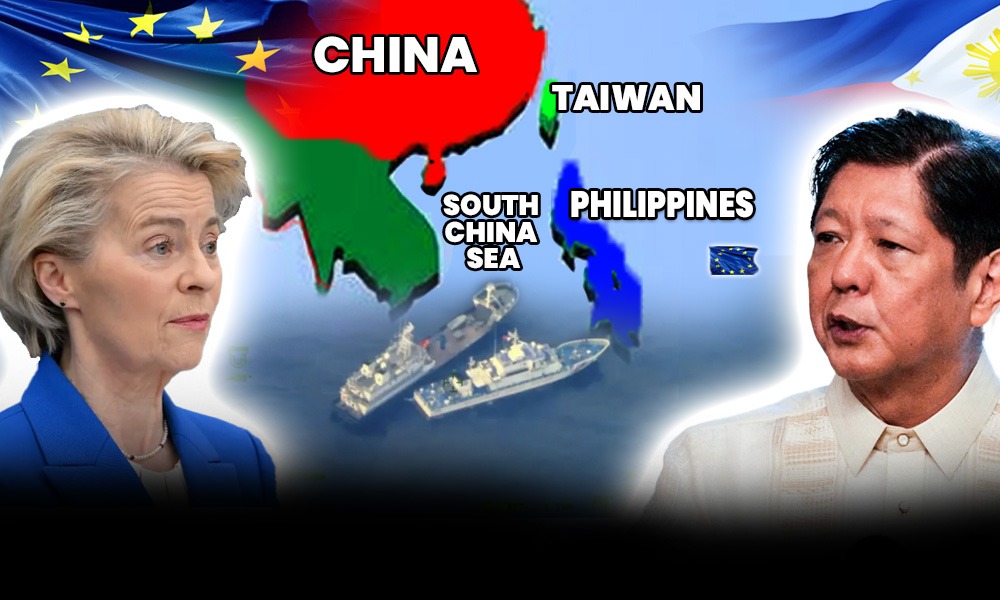Philippines Triples Patrol Area in South China Sea – Boosts Deterrence
The Philippines has taken one of its boldest defense steps yet in the ongoing South China Sea dispute, a sweeping decision to triple its patrol area in the West Philippine Sea (WPS). This strategic expansion signals a major policy shift away from years of cautious diplomacy and reactive defense posture toward a more assertive and transparent approach to national security.
At the heart of this move lies a deepening conflict with the People’s Republic of China (PRC), whose aggressive “grey-zone” tactics, including the use of coast guard ships, maritime militia, and water cannon attacks, have become an almost daily challenge for the Philippine Coast Guard (PCG) and Navy. These actions continue despite the landmark 2016 Permanent Court of Arbitration (PCA) ruling, which overwhelmingly invalidated China’s expansive “nine-dash line” claim and affirmed the Philippines’ sovereign rights over its Exclusive Economic Zone (EEZ).
Faced with growing coercion, Manila has introduced a new and highly visible defensive doctrine known as “assertive transparency.” This strategy involves actively documenting, publicizing, and condemning Chinese incursions in real time, turning every act of intimidation into a matter of global scrutiny. As one Philippine defense official explained, the approach aims to “shine light on the truth” and impose diplomatic and reputational costs on Beijing for its unlawful behavior.
In essence, this new posture reflects a strategic recalibration, one that blends military readiness with information warfare and diplomatic leverage. It is not just about expanding patrol routes; it’s about ensuring that every kilometer of Philippine waters is seen, monitored, and defended both on the ground and on the world stage.
The Philippines’ effort to triple its patrol area in the West Philippine Sea is backed by hard data and a clear strategic vision. According to the National Maritime Council (NMC), this dramatic increase in coverage is a direct result of deploying more ships and aircraft across contested waters. As NMC spokesperson and Undersecretary Alexander Lopez explained, “With our assets deployed, we were able to cover three times more of the West Philippine Sea, we have covered the West Philippine Sea quite abundantly.” This statement reflects not only expanded operations, but a growing confidence in defending national maritime space.
Operational figures from the third quarter of 2025 highlight the scale of activity behind this shift. A total of 224 surface patrol missions were carried out by combined forces from the Armed Forces of the Philippines, the Philippine Coast Guard, and the Bureau of Fisheries and Aquatic Resources. These sea patrols were complemented by 43 air missions and 56 ISR, intelligence, surveillance, and reconnaissance operations, creating a layered monitoring network across key maritime zones. Combined, these efforts saw Philippine forces operate across more than 77,000 nautical miles, demonstrating sustained presence and coverage where Chinese vessels have previously roamed freely with little resistance.
More than just statistics, this patrol surge represents a deeper transformation in Philippine maritime policy. Analysts describe it as a shift from “monitoring and protesting” to “actively governing” maritime territories. Instead of simply documenting intrusions or filing diplomatic notes, the government is now implementing a permanent, proactive maritime domain awareness (MDA) program intended to ensure continuous visibility, accountability, and tactical readiness at sea. This approach signals a long-term commitment to protecting sovereign waters, one backed by data-driven patrols, inter-agency cooperation, and a clear message: Philippine waters will be patrolled, governed, and defended, not abandoned or ceded.
Case Studies of Chinese Aggression and Flashpoints
The Philippines’ decision to expand its patrol operations across the West Philippine Sea is not a theoretical shift, it’s a measured response to a long string of dangerous encounters and escalating acts of Chinese aggression. These flashpoints, documented over the past two years, illustrate why Manila has chosen to adopt a more assertive and transparent approach in defending its maritime rights.
At the center of these incidents is Second Thomas Shoal (Ayungin Shoal), home to the grounded BRP Sierra Madre, a Philippine Navy outpost since 1999. This rusting ship, manned by Filipino marines, relies on constant resupply missions that have become flashpoints for confrontation. In June 2024, one of the most serious clashes occurred when Chinese Coast Guard personnel intercepted a resupply convoy, using high-pressure water cannons and executing dangerous blocking maneuvers. Reports later confirmed that some Chinese crew members were armed with knives and even an axe, resulting in injuries to Filipino sailors, one losing a finger, and significant damage to supply boats. Though both governments later pledged to de-escalate in July 2024, Chinese vessels merely shifted their focus elsewhere, continuing a pattern of intimidation under a new guise.
Another persistent hotspot is Scarborough Shoal (Panatag Shoal), a rich fishing ground well within the Philippines’ Exclusive Economic Zone but under Chinese control since 2012. Between August 2024 and May 2025, observers recorded 121 days of direct interactions between Chinese and Philippine vessels in this area, averaging about 12 days of encounters per month. These stand-offs often involve dangerous shadowing and blocking tactics. In February 2025, a new escalation occurred when a Chinese PLA Navy helicopter made an unsafe interception of a Philippine Bureau of Fisheries aircraft, reportedly coming within three meters (10 feet) of its wing, a reckless act that risked midair collision.
Farther west, in Whitsun Reef (Julian Felipe Reef) and Sabina Shoal, Chinese coercion has taken on a swarm-like form. In December 2023, the Philippine Coast Guard detected over 135 Chinese vessels clustered in formation at Whitsun Reef, up from 111 vessels the month before, signaling an organized occupation tactic. Similarly, in August 2024, Chinese Coast Guard ships rammed and fired water cannons at Philippine patrol vessels near Sabina Shoal, damaging their hulls and forcing retreat. These recurring attacks have transformed once-quiet reefs into symbols of persistent resistance and sovereignty testing.
The pattern extends beyond individual flashpoints. Regional monitoring data shows that the number of Chinese maritime militia vessels operating across the South China Sea surged by 35% in 2023, with an average of 195 vessels deployed daily. At the same time, Chinese Coast Guard patrols logged 1,939 total ship days in 2024, up from 1,652 the previous year, across six major contested zones, according to the Asia Maritime Transparency Initiative (AMTI).
Together, these figures paint a clear picture: the Philippines is facing systematic, sustained pressure across multiple fronts. Each flashpoint, from the Sierra Madre to Scarborough and Whitsun, reinforces the same message: assertive patrols are no longer optional, they are essential. By tripling its patrol presence, Manila is not only defending its sovereign rights but ensuring that every act of aggression is met with visibility, resilience, and accountability on the world stage.
Ukraine’s Combat UAV Steals the Show at Philippines Defense Exhibition
Boosting Deterrence: Modernization and Alliance Building
The Philippines’ expanded patrol coverage in the West Philippine Sea is not happening in isolation, it’s underpinned by a fast-moving program of maritime modernization and strategic alliance building. These efforts, combining new hardware, infrastructure, and stronger military partnerships, aim to transform the country’s maritime defense from a reactive stance into a proactive deterrent force. Manila’s strategy is clear: to ensure that every patrol is backed by credible capability, every confrontation met with readiness, and every alliance leveraged for collective security.
The heart of this modernization push lies in a significant expansion of the Philippine Coast Guard’s (PCG) fleet and surveillance capabilities. Under a $438 million (₱25.4 billion) acquisition program, the PCG is purchasing 40 new fast patrol boats from the French shipbuilder OCEA. These vessels, each 35 meters long and capable of speeds up to 35 knots, are designed for high-speed pursuit and maritime law enforcement operations, ideal for intercepting intruding vessels and conducting rapid-response missions in contested waters. Their arrival will mark one of the largest upgrades to the PCG’s operational fleet in decades, directly addressing the need for agility and presence in the vast maritime domain.
In parallel, Japan continues to play a critical role as one of Manila’s top maritime partners. The PCG is acquiring five additional 97-meter multi-role response vessels (MRRVs) from Japan, modeled after the BRP Teresa Magbanua, currently one of the largest and most advanced ships in the Philippine Coast Guard’s inventory. These long-range ships are built for sustained patrols, search and rescue missions, and extended operations in rough seas, precisely the kind of endurance capacity the Philippines needs to maintain a year-round presence in the West Philippine Sea.
Infrastructure is also part of this modernization wave. On Pag-asa Island (Thitu Island), one of the Philippines’ most strategically located outposts, a state-of-the-art coastal monitoring station was completed in early 2024. The facility is equipped with advanced radar systems, satellite-linked surveillance equipment, and maritime domain awareness (MDA) technology capable of tracking vessels hundreds of kilometers away. This station gives Philippine authorities real-time intelligence over key areas and supports joint coordination with allies, transforming Pag-asa from a remote island into a front-line sentinel of sovereignty.
5 Challenges the Philippines Will Face as ASEAN Chair in 2026
Modernization at home is being reinforced by deepening alliances abroad, particularly with the United States and regional partners. The 1951 Mutual Defense Treaty (MDT) between Washington and Manila remains the bedrock of this security framework. U.S. officials have repeatedly reaffirmed that the treaty applies explicitly to armed attacks on Philippine forces, public vessels, and aircraft in the South China Sea including those operated by the Coast Guard. This clear extension of coverage has effectively drawn a “red line,” deterring further escalation by showing that any aggression against Philippine units could trigger a U.S. military response.
Further strengthening operational readiness, the Task Force–Philippines, a newly established joint initiative, is now focusing on coordinated patrols and rapid crisis response in contested areas such as the South China Sea and the Luzon Strait. This structure mirrors NATO-style task forces and ensures that Philippine and U.S. forces can move in sync, sharing intelligence, logistics, and command systems for both deterrence and defense.
At the multilateral level, regional cooperation is accelerating. The Philippines’ role as a hub for joint naval exercises has expanded significantly, with activities like Sama Sama 2025 bringing together forces from the U.S., Japan, Australia, Canada, France, and New Zealand. These exercises go beyond symbolic gestures, they simulate real-world combat scenarios, joint rescue missions, and complex interoperability drills, building trust and readiness among allied navies.
In sum, the Philippines is pursuing a layered approach to deterrence: modernize, integrate, and ally. By investing in modern ships, advanced surveillance, and stronger partnerships, the nation is asserting both sovereignty and solidarity, ensuring that its defense of the West Philippine Sea rests not on rhetoric, but on readiness.
U.S. Missiles in Philippines Can REACH China Faster Than You Think
Conclusion: Geopolitical Ramifications and Future Outlook
The Philippines’ decision to triple its patrol area and adopt a policy of “assertive transparency” has transformed the security dynamics of the West Philippine Sea. It is more than just a tactical move, it is a calculated deterrence strategy aimed at raising the cost of China’s coercive and “grey-zone” tactics. By increasing visibility and documenting every act of aggression, Manila hopes to shift the balance of accountability, making Beijing’s actions not only militarily risky but diplomatically costly. As the Philippine National Maritime Council stated, China’s continued provocations “call into question China’s supposed commitment to de-escalate the situation.” In other words, transparency has become the Philippines’ most effective weapon, exposing illegal actions and rallying international support.
Yet this assertive stance carries significant risks. The South China Sea remains one of the world’s most vital and volatile waterways, with an estimated $3 trillion worth of global trade passing through it each year. The dense presence of fishing fleets, coast guards, and naval vessels from multiple nations makes every encounter a potential flashpoint. At Scarborough Shoal alone, there have been an average of 12.1 days of interaction per month between Chinese and Philippine vessels, a tempo that drastically increases the risk of an accidental collision or escalation.
Such an incident could have far-reaching consequences. Under the 1951 U.S.–Philippines Mutual Defense Treaty, any armed attack on Philippine forces or public vessels in the South China Sea could trigger an American military response, a scenario that could spiral into a broader regional crisis. The Philippines, therefore, finds itself in a delicate balancing act: asserting its sovereign rights while managing the razor-thin line between deterrence and provocation.
Looking ahead, Manila’s expanded patrols and growing alliances signal a nation reclaiming its maritime agency. The challenge now is to sustain this deterrence without tipping into confrontation, to defend its waters with firmness, transparency, and the steady hand of diplomacy. The West Philippine Sea has become the testing ground not only for Philippine resolve but for the region’s ability to maintain peace through strength.



